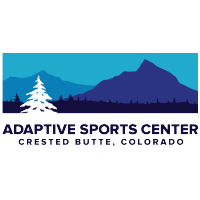HCDS Adaptive Climbing Rig – F20-15.2
Overview
A person may be diagnosed with paraplegia, or lower limb paralysis, following trauma, a disease, or a congenital condition. Paraplegia is a devastating condition, not only to the physical state but these injuries often will drastically change a person’s lifestyle [1]. There are currently adaptive devices available to people with amputations, however, these solutions are not generally accessible to paraplegics. The client, Adaptive Sports Center (ASC), is one of Colorado’s leading organizations for adaptive sports. They help people with any sort of disability experience activities like mountain biking, skiing, or rock climbing. The goal of this project is to give paraplegic climbers more independence when rock climbing indoors and outdoors with ropes. A large part of climbing for people without paraplegia is the ability to use their legs to relieve muscle strain from the upper extremities [2]. The client base will not have this luxury, since they have limited use of their lower extremities. These are a few things that the team kept in mind during the design process.
Final Design CAD Model Assembly
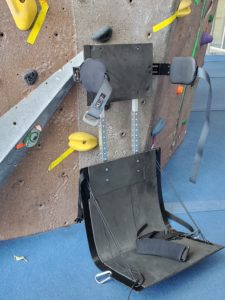
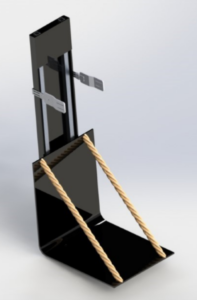
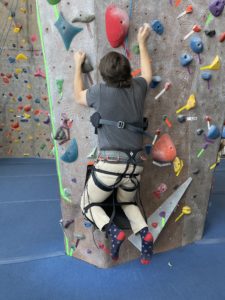
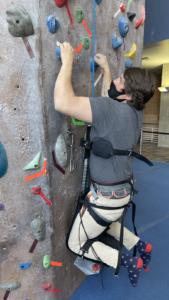
Climb Testing
Live Zoom Chat
Use the link below to join us live from 8:00 – 10:30 a.m. on April 29th.
Or iPhone one-tap: 12532158782,93504851715# or 13462487799,93504851715#
Or Telephone:
Dial: +1 253 215 8782 (US Toll) or +1 346 248 7799 (US Toll)
Meeting ID: 935 0485 1715
Team Members
- Garron Tubbs
- Lindsey Jin
- Michelle Rugh
- Rebecca Michalczyk
- Ryan Kreigler
- Shri Nandoor
- Claire Edington
- Mack Minnehan
The Client
- Adaptive Sports Center
Video
Elevator Pitch
Colorado is one of the most active states with outdoor activity at the heart of daily routine. Residents of all ages enjoy time spent outdoors walking, biking, hiking, skiing and more. Here at the Human Centered Design Studio, members combine their passion for the outdoors and interest in helping others to engineer solutions to improve the experience of those with physical limitations. These products empower all individuals to enjoy sports and the outdoors in confidence.
Our client, The Adaptive Sports Center, reached out to HCDS at Mines to assist in the development of a manufacturable and marketable new product. The team was tasked with engineering a climbing rig for paraplegic users that provided a balance between safety and comfort. The team accomplished this on both fronts. Keeping manufacturability and assembly in mind, the team iteratively designed and developed an adjustable support that accomplished weight, strength, and comfort specifications.
Design Approach
The overall objective of this project is to provide a device that rock climbers with lower extremity injuries can use to traverse their routes easier and safer. To achieve this goal, the team identified the key deficiencies in the previous design of the climbing rig mechanism. After conducting a field test of the previous design, the team pinpointed areas for improvement. Communication with the client as well as testing led to the development of key design specifications to provide objectives for the project.
The goals of the project are to redesign last year’s climbing rig to be lighter, increase the ease of use, decrease the impact of the rig on the climber’s ascent, and be more supportive in the lateral direction of the user. With these goals in mind, the rig was divided into three core subsystems to optimize the design. The bucket, lateral support, and chest piece subsystems each used decision matrices to select the best design solution. The common criteria used to evaluate proposed solutions included: safety, cost, weight, ease of use, and manufacturability. The design matrix for the bucket subsystem is shown below for reference. Upon completion of the decision matrices, the final design for the climbing mechanism was developed. Finite element analysis was used to verify the structural integrity of the design. Lastly, user testing was conducted to verify and validate the final design.
The final solution addressed each of the specifications outlined in the beginning of the design process. The final bucket design provided a lighter weight, simplified carriage system to support the legs of the user. The lateral support system increased the user’s control of their torso and limited rotation. Additionally, the chest plate provided support and protection against obstacles encountered while climbing. The final prototype was designed using a budget of under $300. The design is intended to be customizable to a variety of users. The chest plate and lateral supports were designed with built in adjustability mechanisms to provide the optimal experience for each individual user. Though only one prototype was created, the design can be replicated as requested.
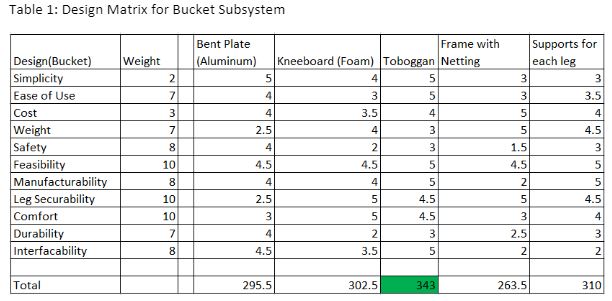
Building the Prototype
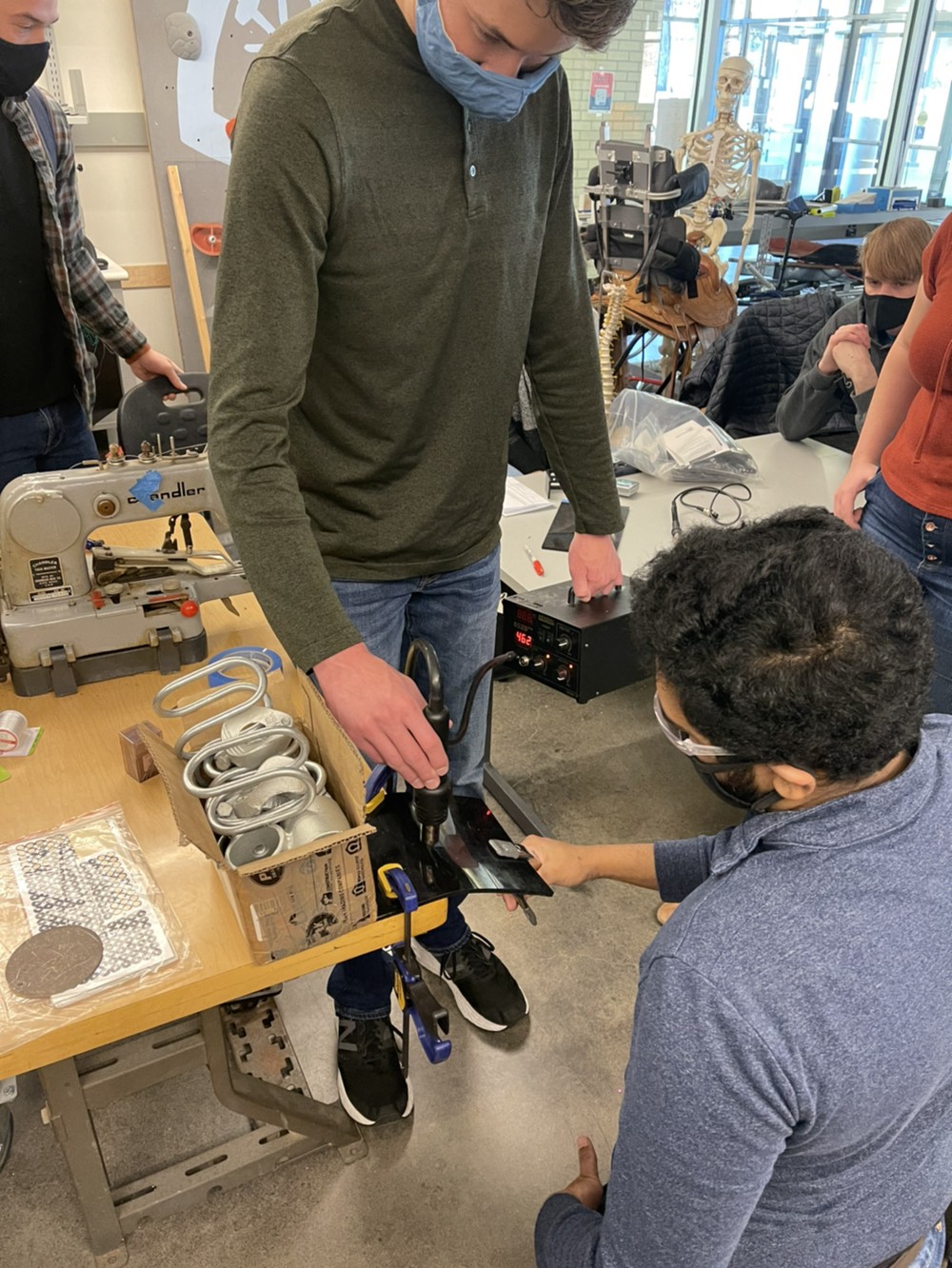
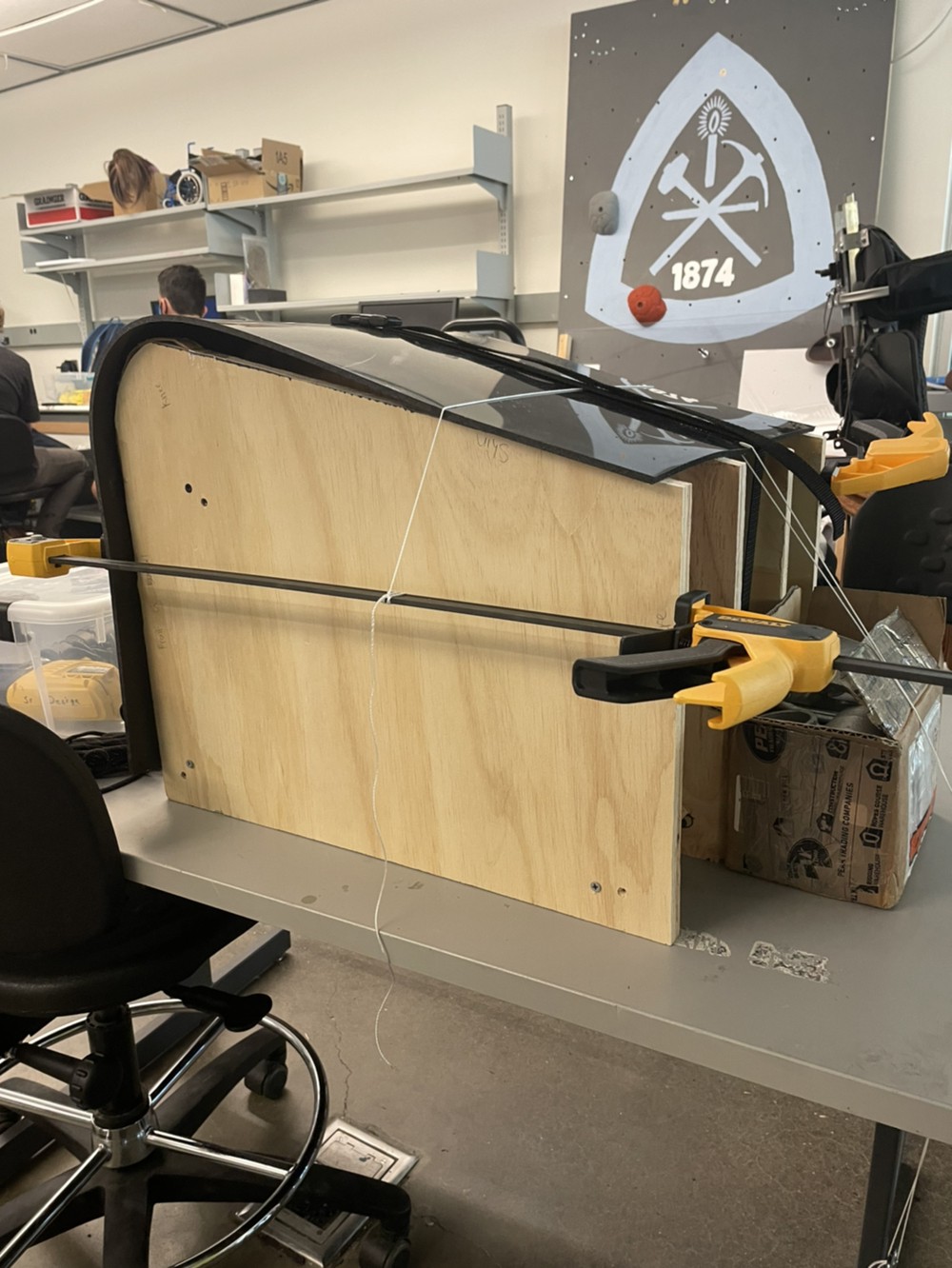
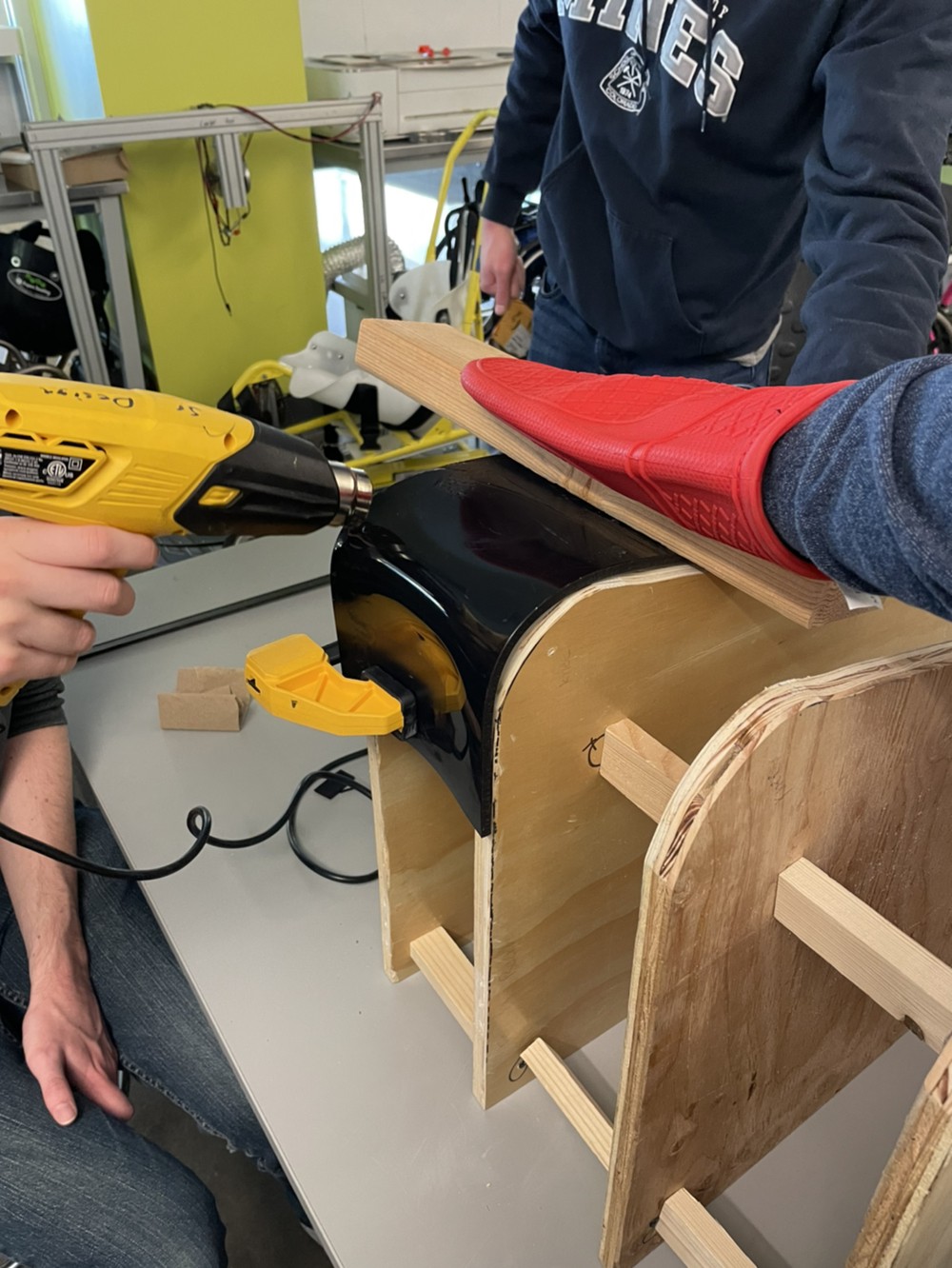
Design Solution
Bucket
The first subsystem is the bucket designed to keep the climber’s legs stationary while climbing to eliminate any uncomfortable leg movement or positioning. The bucket utilizes a 0.187-inch-thick sheet of polypropylene copolymer that is bent at 85 degrees with an arc length of 6 inches for a comfortable knee bend.
The climber’s legs extend past the end of the bucket from the lower shin. This allows for the legs to be supported with minimum bending of the ankles. The bucket utilizes two straps to keep the climber secured to the bucket. The lower strap attaches around the calves keeping the lower legs in contact with the bucket. The upper strap positions the hips close to the rig to keep the hips from rotating out. These straps are adjustable and can be used for many different climbers. Foam padding covers the bucket to eliminate rubbing and take pressure off the limbs. The foam is secured using a professional strength adhesive which keeps the foam firmly attached while in use.
Bucket CAD Model
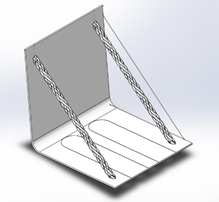
Laterals
The team’s design utilizes lateral supports manufactured for wheelchairs. This provides support for the torso when climbing which also fixed issues with the rig rotating as the climber moves up the wall. The supports are attached to the chest piece and are adjustable for a range of users. The maximum width of the lateral supports is 20 inches with a minimum of 15 inches. Most of the users will be able bodied with muscular torsos and will fit within this range. The lateral supports are positioned such that the climber can rest on them when getting into the rig. When climbing, the laterals can be used as a rest for the climber’s arms when the rope is holding them. The climber in rig will also have the belt secured around their back to increase their stability and prevent them from sliding backwards out of the rig. This increases the overall torso stability of the climber and effectiveness of the rig [3].
Laterals CAD Drawing
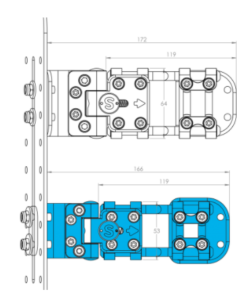
Chest Piece
The chest piece subsystem connects the lateral supports to the bucket discussed above. The chest support itself consists of two square aluminum rods between an aluminum plate and two plastic plates. The chest plate is connected to slightly larger steel strutted square tubes with a snap adjustor. This allows the chest plate to be adjusted for various torso heights for maximum efficiency and comfort. The aluminum plate mentioned above connects the lateral supports to the rest of the rig. This bolt connection can easily be loosened to allow for the lateral supports to be adjusted in and out to accommodate different torso sizes. The chest piece is an integral part of the rig and allows for the most adjustment between users.
Chest Piece CAD Model
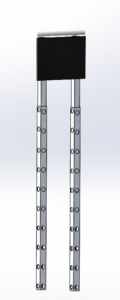
The videos below highlight the key differences between the first and second iteration of the adaptive climbing rigs. The first video shows how the climber’s hips are more secure to the rig in the second iteration with the additional strap. The second video shows how the climber’s knees are securely fixed to the base due to the improved structure of the bucket system. The final video shows how the lateral supports prevent the climber’s torso from twisting.
Next Steps
While successful in fixing the problems of the initial design, the team is confident that the climbing rig can be continuously improved. Through iterative testing and prototyping the team was able to develop a design the met current design specifications. However, due to the current pandemic, one outstanding task is to conduct field testing with paraplegic users to make necessary adjustments.
The next steps which should be taken for the adaptive climbing rig project include:
-
- Conduct testing with paraplegics to attain more user specific feedback on the design
- Reducing the overall weight of the rig by incorporating lighter weight materials such as aluminum
- Create a standardized mold to allow for mass production of the bucket subsystem
- Incorporate an additional support stand to allow the user to get in the rig independently
The Adaptive Sports Center should be consulted to ensure all their expectations are still met or exceeded after any modifications are made to the design.
Meet the Team
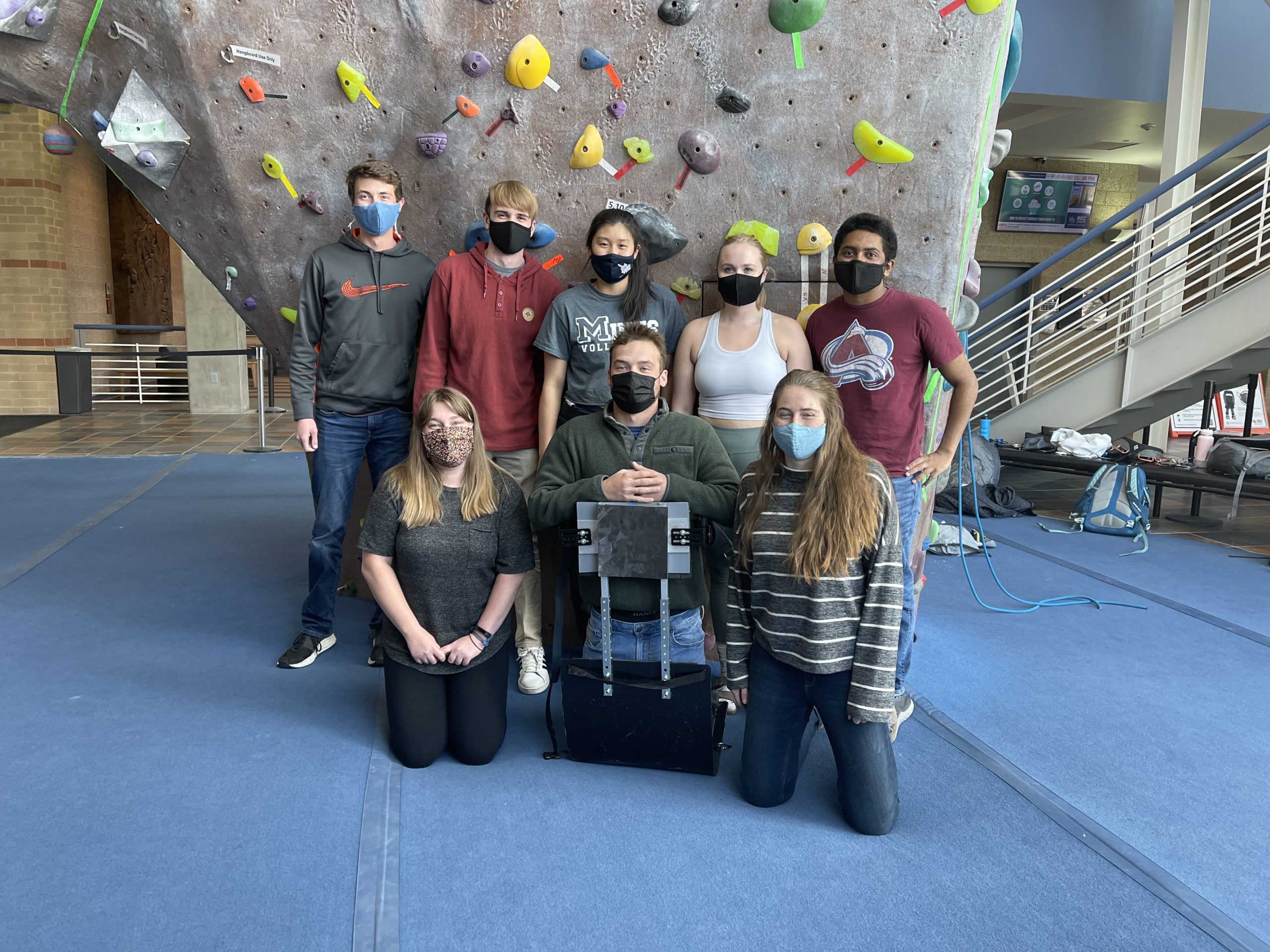
Lindsey Jin
 Lindsey Jin is a 4th year Mechanical Engineering Student from Colorado Springs, Colorado hoping to graduate in May of 2021. At Mines she plays on the varsity volleyball team. They have won the RMAC conference tournament every year she has played. After she graduates, she hopes to complete a Master’s degree in bio-mechanical engineering and start a career in that field as well.
Lindsey Jin is a 4th year Mechanical Engineering Student from Colorado Springs, Colorado hoping to graduate in May of 2021. At Mines she plays on the varsity volleyball team. They have won the RMAC conference tournament every year she has played. After she graduates, she hopes to complete a Master’s degree in bio-mechanical engineering and start a career in that field as well.
Garron Tubbs
 Garron is a graduating mechanical engineering student planning to return to Colorado School of Mines for his master’s degree, where he will specialize in biomechanical engineering. In his free time, he enjoys outdoor activities like soccer, hiking, and skiing. He is excited about the progress of this project and eager to see it finally in use.
Garron is a graduating mechanical engineering student planning to return to Colorado School of Mines for his master’s degree, where he will specialize in biomechanical engineering. In his free time, he enjoys outdoor activities like soccer, hiking, and skiing. He is excited about the progress of this project and eager to see it finally in use.
Michelle Rugh
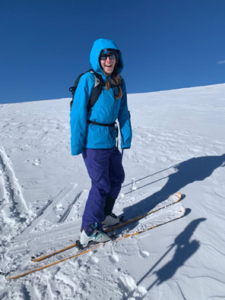 Michelle Rugh is graduating this semester with her Bachelors degree in Mechanical Engineering with an area of emphasis in aerospace. When she is not in class, she enjoys hiking, skiing, camping, and reading. She has climbed 40 of Colorado’s 14ers and plans on completing all of them in the next few years. She loves to ski and can be found on the slopes close to 28 days in the winter. She is continuing on to earn her Masters degree in Thermal and Fluid systems in Mechanical Engineering here at Mines in December 2021. She will also be continuing to work at Lockheed Martin and cannot wait to see what she can do after she graduates.
Michelle Rugh is graduating this semester with her Bachelors degree in Mechanical Engineering with an area of emphasis in aerospace. When she is not in class, she enjoys hiking, skiing, camping, and reading. She has climbed 40 of Colorado’s 14ers and plans on completing all of them in the next few years. She loves to ski and can be found on the slopes close to 28 days in the winter. She is continuing on to earn her Masters degree in Thermal and Fluid systems in Mechanical Engineering here at Mines in December 2021. She will also be continuing to work at Lockheed Martin and cannot wait to see what she can do after she graduates.
Rebecca Michalczyk
 Rebecca Michalczyk is from Bailey, Colorado. She is a Senior in Mechanical Engineering, graduating this May 2021. After graduation, she will be working as a full time Systems Engineer for Raytheon Intelligence and Space. In her free time, you can find her rock climbing, painting, or hanging out with her dog.
Rebecca Michalczyk is from Bailey, Colorado. She is a Senior in Mechanical Engineering, graduating this May 2021. After graduation, she will be working as a full time Systems Engineer for Raytheon Intelligence and Space. In her free time, you can find her rock climbing, painting, or hanging out with her dog.
Shri Nandoor
 Shri Nandoor is a 4th year Mechanical Engineering student. Over the years he has been involved with the peer mentor program, entrepreneurship club, robotics team, sports analytics club, and AIAA on campus. His hobbies include cooking, hiking, skiing, and playing recreation sports which inspired him to pursue a senior design project with the Human Centered Design Studio. After graduation he plans on starting his career as a Mechanical Engineer at Lockheed Martin.
Shri Nandoor is a 4th year Mechanical Engineering student. Over the years he has been involved with the peer mentor program, entrepreneurship club, robotics team, sports analytics club, and AIAA on campus. His hobbies include cooking, hiking, skiing, and playing recreation sports which inspired him to pursue a senior design project with the Human Centered Design Studio. After graduation he plans on starting his career as a Mechanical Engineer at Lockheed Martin.
Ryan Kreigler
 Ryan Kreigler is a Senior from Colorado Springs, Colorado. He is graduating this semester with his Bachelor’s degree in Mechanical Engineering. In his free time, he enjoys hiking, photography, and recreational sports. After graduation he will be pursuing a career in the aerospace industry.
Ryan Kreigler is a Senior from Colorado Springs, Colorado. He is graduating this semester with his Bachelor’s degree in Mechanical Engineering. In his free time, he enjoys hiking, photography, and recreational sports. After graduation he will be pursuing a career in the aerospace industry.
Claire Edington
 Claire is a fourth year student at the Colorado School of Mines pursuing a Bachelor’s degree in Mechanical Engineering and a minor in Public Affairs.
Claire is a fourth year student at the Colorado School of Mines pursuing a Bachelor’s degree in Mechanical Engineering and a minor in Public Affairs.
Mack Minnehan

Mack will graduate this spring with a BS in Mechanical Engineering. He plans to continue his education with a focus in Biomechanics, while having project management experience. As a team member, Mack has helped identify the alarming biomechanical deficiencies that was credited to the previous design. To add, he has provided his limited climbing knowledge in hopes to present continuous improvements to the current design. Outside of his schoolwork, Mack plays outside linebacker for the Colorado School of Mines football team.
Citations
- Types and Levels of Spinal Cord Injury,” Spinal Cord Injury Levels, Types of Spinal Cord Injuries. [Online]. Available: https://www.shepherd.org/patient-programs/spinal-cord-injury/about/levels-and-types. [Accessed: 05-May-2020].
- “Rock Climbing,” Move United. [Online]. Available: https://www.moveunitedsport.org/sport/rock-climbing/. [Accessed: 05-May-2020].
- “Spex Axial Swing Away Lateral Hardware” [Online]. Available: https://www.spexseating.com/products/lateral-trunk-supports/axial-swing-away-lateral-hardware. [Accessed 15-November-2020].
